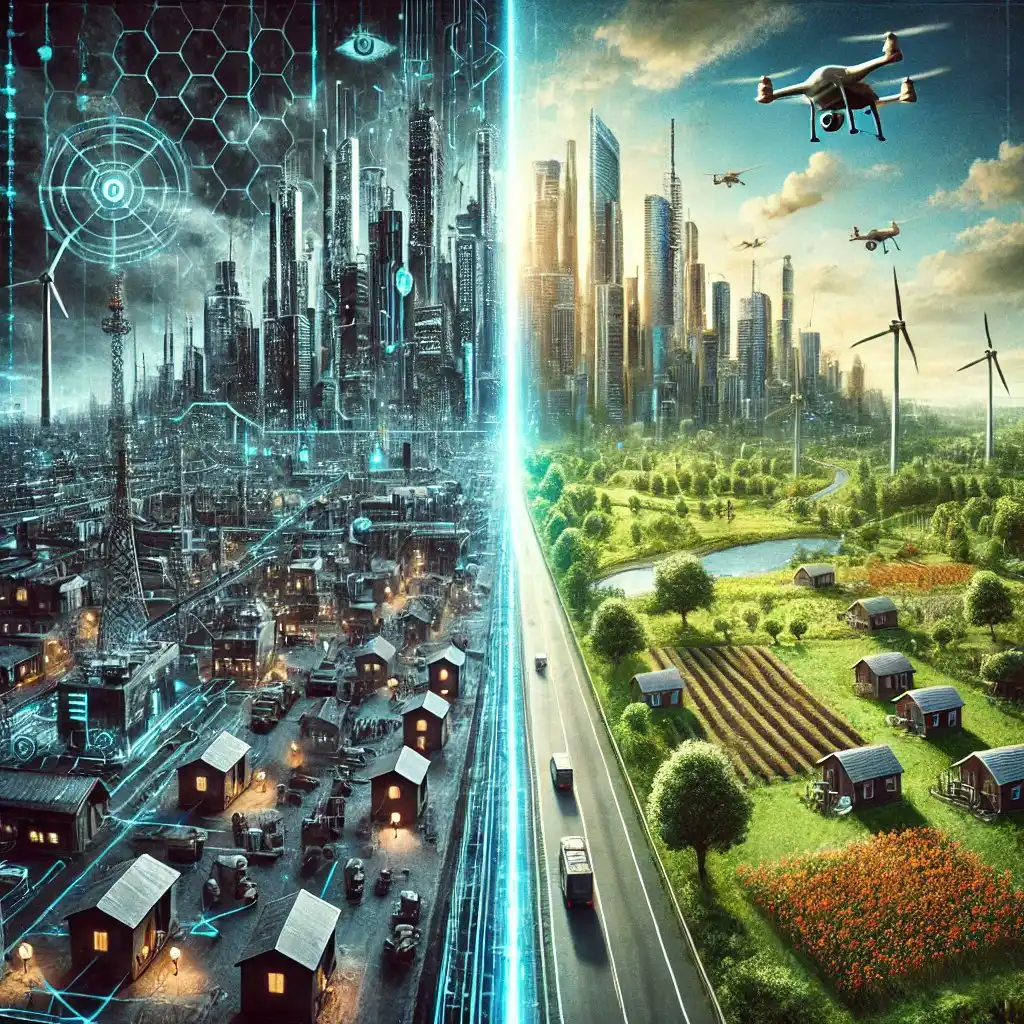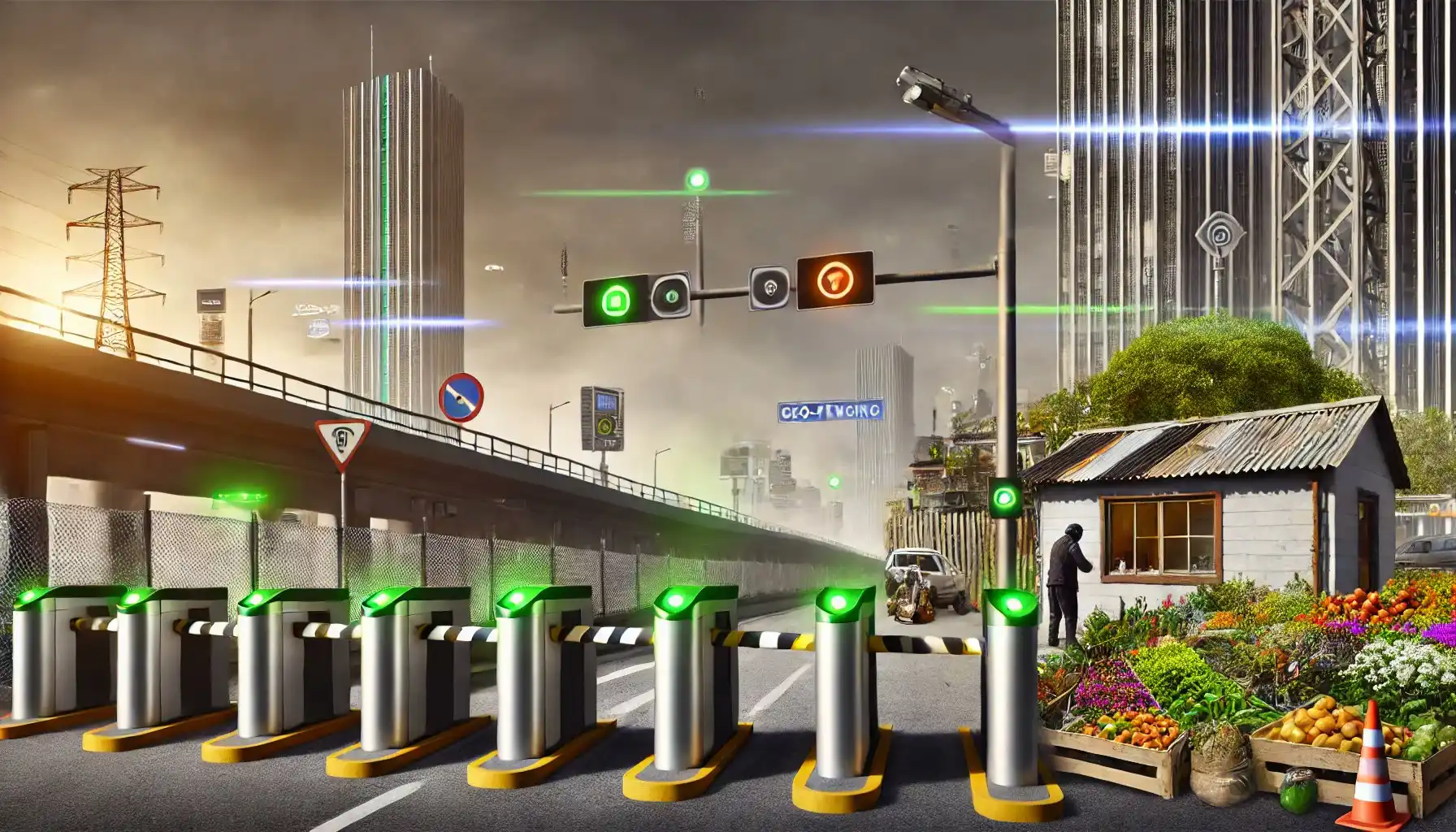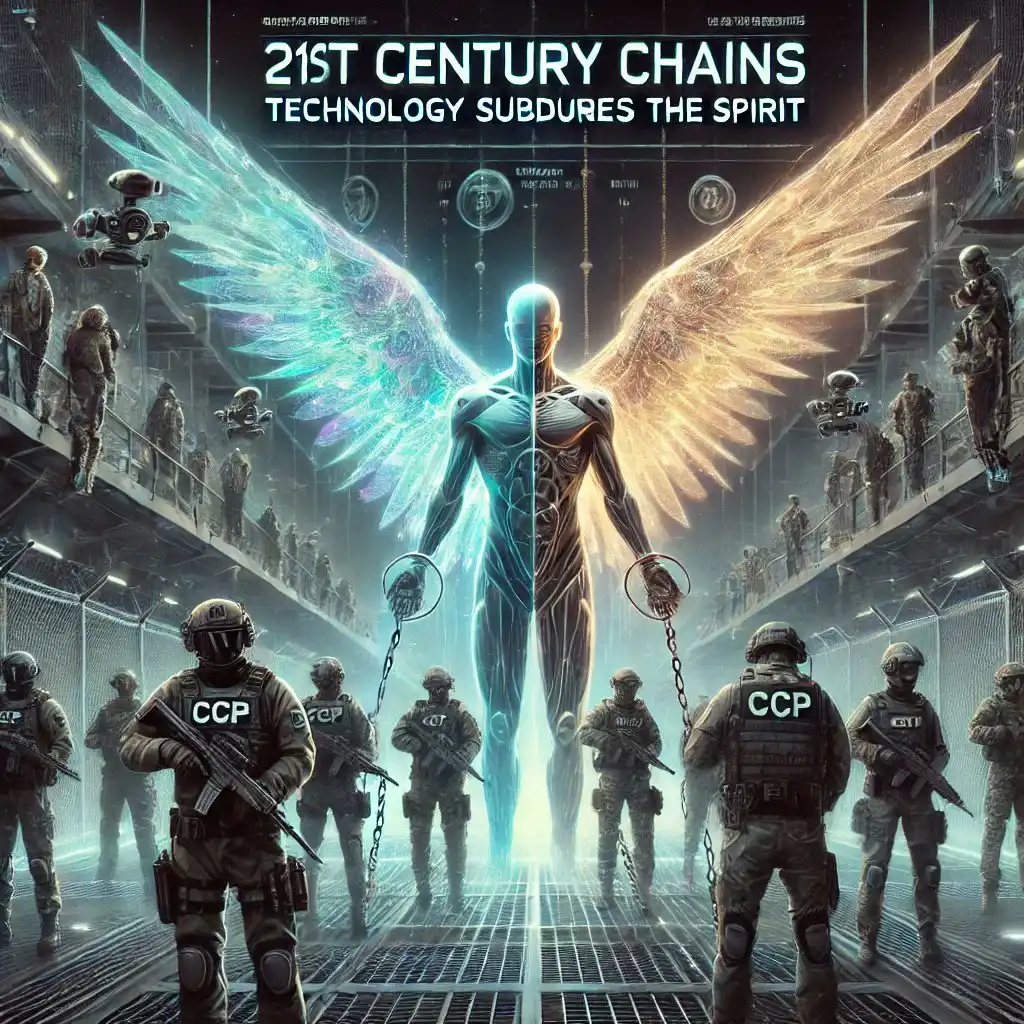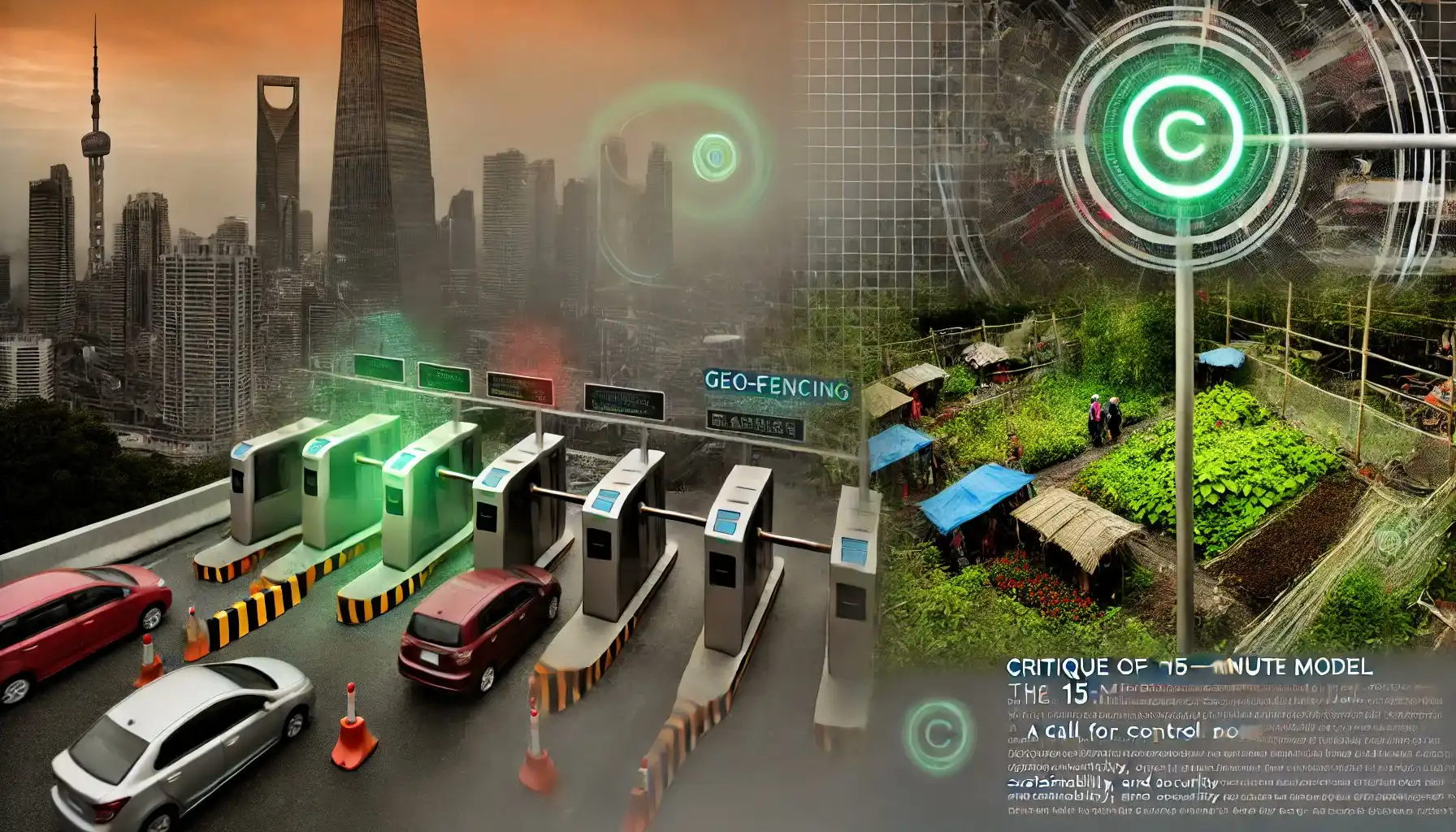@SkillsGapTrain @AmberHaze_xxx ‘The basic amenities like food and healthcare facilities are not provided directly through the technological or infrastructural components of the 15-minute city.’
‘The 15-minute city concept involves additional infrastructure and technological investments from tax payer, that do not directly contribute to the establishment of amenities like grocery stores or healthcare services.’
‘You are talking about a different subject.’
‘So we did 10 seconds of research to see if we can all understand this better.’
Introduction
The concept of the “15-minute city” often emphasizes the proximity of amenities like grocery stores, healthcare services, and leisure facilities within walking or cycling distance of residences. While this may sound beneficial on the surface, a deeper analysis reveals several flaws that could pose significant risks to taxpayers, infrastructure stability, economic security, resource security, life systems security (farming) and national security, especially in a rapidly evolving geopolitical landscape.
1. Hidden Costs and Financial Burden on Taxpayers: The 15-minute city model relies on a host of expensive technologies, such as:
Social Credit Systems for Zone Compliance
‘This is not an exhaustive list. It’s likely much longer. Also, it is not to be underestimated, each line item here, it can cost over 100k. For example, say that your classification of your house has to be upgraded to higher efficiency. Then you either pay for the upgrade, or are forced to sell the house to Blackrock and live in rent.’
‘Also, these electronic control points, on first impression it looks like a type of physical manifestation of the administrative legal controls, but brought into the world electro-mechanically and in terms of behavioural engineering, to shape the operation of citizens. Ex: Less Free Will and Less Agency.’
‘It’s an advanced prison system. Some of these technologies are already employed in maximum security prisons.’
Implementing these features across a city, particularly in Western countries with high labour and material costs, would require substantial public investment.
For example, just a single component like Automated Vehicle License Plate Recognition (ALPR)systems can cost millions to deploy and maintain in even a small urban area. It would require yearly expenditures to upgrade these systems over time, similar to how Millenials spent their life savings to buy a new computer every 1 to 5 years, for the last 30 years. The cities would be on the hook for electronics upgrades, yearly, and in perpetuity.
This could theoretically damage the budget of Canada (take the wealth of national debt from Millenials and Gen Z by increasing the national debt rapidly and perpetually), and cause extreme resource depletion of minerals and elements, resulting in a future without technology production capability after a few decades, as critical elements would be mined and consumed throughout the exponential rise of human growth, city prison system growth around the world for all cities, and intelligence robot production systems around the world (which could be 10 billion or more robots, that too all need to be maintained and upgraded yearly). So they want to take away the car, so that the materials can be used for robots and prison systems.
When multiplied by 50 different technological systems across a metropolitan region, not just one entry of the above list, the total cost could be the most enormous cost item in the budget. This translates to an additional tax burden for residents, potentially increasing their lifetime contributions by hundreds of thousands of dollars, at the very leas, possibly millions with current inflation rates.
Given Canada’s demographic challenges and a shrinking working-age population, fewer taxpayers will bear an increasingly heavy burden. This could lead to higher national debt and economic stagnation, diverting funds away from critical areas like healthcare, education, and infrastructure maintenance, technological production, manufacturing, resource export systems, energy export systems, space systems development, education modernization, public safety modernization, national security scale up and modernization, etc.. hobbies for youth like RC cars, car autonomous races and rocketry experiments.
2. Lack of Life-Support Systems and Over-Reliance on External Supply Chains:
Despite the extensive technological infrastructure proposed in the 15-minute city model, there is a glaring absence of provisions for self-sufficiency. For example, in British Columbia, over 2/3rds of food is imported, this was mentioned by John Rustad recently. Yet, the 15-minute city plan allocates minimal resources to developing local food production capabilities. If only 2% of the budget is dedicated to community gardens or urban farming, while 98% goes to accessory systems like smart cameras and dynamic tolling, the city’s resilience in the face of a supply chain disruption is severely compromised, and everyone faces famine and death should supply chain be interfered with.
‘Conspiracy theorists will have a field day with this one — the loophole for potential depopulation emerges from a low agricultural base combined with the high EMP risk to centralized infrastructures, further exacerbated by the 15-minute city model. This model could lead to sprawling dystopian mega-slums of 2 to 10 million people, predicted by Sci-Fi films like Judge Dredd, creating critical single points of failure for the centralized city architecture (all eggs in one basket).’
‘And it looks like this will be a key point of weakness and interference in 21st century, supply chains and “critical infrastructure”, none of which are addressed by “15 minute cities”. (See: Amazon Bookstore on emerging crises, threats, risks and dangers from 2020 to 2050’
If a city plan has 50 tech components and only 1 of these components is dedicated to community gardens, it shows a grossly disproportionate emphasis on control mechanisms over life-support systems. It shows a preference for Artificial Intelligence instead of humanity, as the next species.
What happens if the 49 other components, which are merely accessory and administrative functions/legal functions extensions via technology into reality, receive the lion’s share of funding while the essential 1-5% farming and rural life is allocated to true life-support elements?
This imbalance in the 15 minute city upgrade model, could prove catastrophic.
‘A robust and well-thought-out city design must ensure that core life-support systems are at the forefront of planning, not an afterthought. Say 50% funding level for rural life support aspects, and 50% for tech city aspects.
‘So if you truly want groceries and you truly want doctors, and families and births which is associated with people that care about groceries and doctors, you would be against this policy.’
In the event of a natural disaster, geopolitical conflict, or economic collapse, such centralized mega cities as 15 minute cities would be with many 15 minute regions — designed to function under ideal conditions — could fail catastrophically. This is predicted in the Sci-Fi film Judge Dredd, and others.
‘Our politicians take us to the dark dystopia, instead of to apply STEM design for positive civilization design.’
A robust city design should prioritize essential life-support systems such as greenhouses, community energy storage (oil, natural gas, batteries, solar modular chargers equipment), and localized water treatment/water filtration equipment (portable as well), responsive emergency centres and not ones that don’t know how to get into a vehicle and do sports shooting, but only know to sit in office all day; ensuring that food, energy, water, medical care, communications, search and rescue AI systems, and security are available locally in times of crisis.
Without these measures, the so-called “smart city” becomes a high-tech trap, leaving millions vulnerable in one central location, and likely the wealthy living in rural location outside the smart city districts, with their own social score access for that zone (life zone). These zones are likely accessible by social score. (wealth).
3. Increased Vulnerability to Geopolitical and Security Threats:
The world is witnessing a rapid re-militarization, with over 12,121 nuclear warheads already in existence and potentially more being held in secret or being developed as emerging powers expand their military capabilities and come online with new knowledge.
A city reliant on centralized, high-tech systems for transportation, energy management, and security is inherently vulnerable. A single missile detonation in the Pacific or Atlantic or in the space above North America somewhere in the sky, could trigger an electromagnetic pulse (EMP) or cyber-attack, incapacitating the digital infrastructure of a 15-minute city and plunging it into chaos, famine and death for up to 90%+ of residents (in a 15 minute city model).
In the aftermath of such an event, with broken supply chains and crippled digital systems, the lack of local food production, water resources, and decentralized energy would mean that 90%+ of the population could face starvation and death within months. A truly resilient city design would not concentrate resources and populations in high-tech enclaves but rather spread them across smaller, self-sufficient units, reducing the risk of catastrophic failure from a single point of attack.
4. Prioritizing Expenditure: The Opportunity Cost of 15-Minute Cities
Pursuing 15-minute cities diverts capital from critical investments in infrastructure and technology that Canada urgently needs. For example, if Canada’s limited financial resources are used up in deploying “smart” systems that mainly serve to control and monitor citizens, there will be little left for developing fusion energy, small modular reactors, or sustainable agricultural technologies and automated agricultural technologies and greenhouses, ship building, and pantries beside peoples houses and cities and towns.
These are the type of sectors that will define Canada’s prosperity and security in the 21st century. Avoiding the cost of importing food, while maximizing revenues from manufacturing goods, exporting resources, technology products and exporting energy.
The opportunity cost is not just theoretical — it’s already visible. Canada’s economic growth has lagged behind other top economies, with the stock market showing minimal movement over the past decade, while other top economies have skyrocketed with tech innovation driving business growth and attracting global capital.
Conversely, hundreds of billions in intellectual capital and actual capital leaves from Canada to invest in USA instead, since we are doing a terrible job in policy (Like 15 minute cities false advertising from corporations about fake prosperity and fake energy system design efficiencies.).
A large part of this stagnation is due to the mis-allocation of capital towards administrative overhead and non-tangible investments that do not yield returns in productivity or technological advancement.
Spending on 15-minute city systems could follow the same path, creating an expensive, over-engineered urban environment that offers little tangible benefit to its residents. Does it produce fighter jets? Does it produce houses? Does it produce doctors? Does it produce PHD’s or PEng workers or MEng. It does nothing. Nothing.
5. A Misguided Focus on Non-Essential Infrastructure:
Supporters of the 15-minute city model argue that it provides better access to healthcare and grocery stores. However, the reality is that hospitals and other critical health infrastructure fall under broader regional and national planning and cannot be adequately addressed within the confines of a single city model. Allocating significant funds to accessory systems like dynamic tolling or social credit enforcement, while neglecting the core needs of healthcare and education (which are not part of 15 minute systems that are going to be added, but are funded separately by current budget systems), will result in a hollowed-out society, where people have digital amenities and digital guidance systems, but lack essential services and opportunities for growth.
Conclusion:
While the vision of a 15-minute city may be appealing (in terms of providing the utopian vision of all of society will be a nice walking park), it is imperative to scrutinize its implementation.
Investing in high-cost digital infrastructure without addressing fundamental life-support systems, local resource production, local manufacturing, factory production of housing, manufacturing systems, business systems, revenue generating systems, economic independence systems, energy independence systems, life commodity food, support, production and independence system, and resilience against geopolitical threats is shortsighted.
‘Let’s not put the cart before the horse, or we may never have horse at all. So far, we don’t even have a horse.’
A balanced approach that prioritizes core infrastructure, promotes local self-sufficiency, and reduces vulnerability to external shocks is essential to ensure the long-term viability and prosperity of urban environments.
The proponents of 15-minute cities must answer critical questions. For example:
How will these cities feed their populations in times of crisis? If the food stops coming from other country? If the money velocity drops to 0? Where does the food come from?
Where is the focus on essential infrastructure development? If the water filtration factory shuts down from Earthquake or flood, do we have a backup water filtration system in the 15 minute city?
If the hospital is overfilled, does the military have a backup hospital in operation for citizens (in case of Pandemic? Is this part of 15 minute city idea? Do we have backup pandemic teams ready to go?
We can generate 1000 more questions, just like any tech person an. None answered.
There are two organizations that make a lot of money and a lot of control from 15 minute city. They own the world if this goes through: CCP & WEF.
And who will bear the financial burden of these costly and largely superficial systems? It’s not the WEF is it? Or does it happen to be Canadians?
‘Paying for your own prison. Congratulations.’
Until these questions are answered with clear and rational strategies, the 15-minute city remains an expensive experiment that could lead to economic and societal collapse for western nations, including Canada of course.
Good luck.
Title: “Hans Zimmer | ULTIMATE Soundtrack Compilation Mix” https://youtu.be/IqiTJK_uzUY?feature=shared




Related Content:
Title: “The Great Filter Ahead: Engineering a Pathway to Complex Civilizational Survival and Overcoming Cosmic Hurdles” https://skillsgaptrainer.com/the-great-filter-ahead-engineering-a-pathway/
Title: “Safeguarding Existence: The Farmer’s Role in an Era of Smart Cities and AI Dominance” https://skillsgaptrainer.com/safeguarding-existence-the-farmers-role/
Title: “The Great Convergence: Resisting the Digital Authoritarianism & Centralized Control of Smart Cities for a Future of Genuine Progress and Freedom”
Title: “Beyond EVs: Top 10 Revolutionary Vehicle Technologies for a Sustainable and Innovative Future” https://x.com/SkillsGapTrain/status/1842412739064410158
Title: “Taking the Life Out of Canada: Systematic Erosion of Security, Prosperity, and National Identity” https://x.com/SkillsGapTrain/status/1842000157874733303
Title: “Blueprint for Resilience: 27 Strategic Actions to Safeguard Humanity’s Future” https://x.com/SkillsGapTrain/status/1839994350610043209
Title: Restoring Justice for Millennials and Gen Z: Addressing Economic Inequities Through Fair Land Redistribution” https://x.com/SkillsGapTrain/status/1839460023484723289
Title:“Report: Optimizing Economic Efficiency through Resource & Energy Exports, Technological Innovation, & Alternatives to Carbon Taxation” https://x.com/SkillsGapTrain/status/1833452615964803277
Title: “Science-Deception: How PM Trudeau Ignores Science and Greta Thunberg Rejects Scientific Study for Activism” https://x.com/SkillsGapTrain/status/1831309288553513314
Title: “A Global Warning: Is Brazil’s Threat to Elon Musk’s X a Sign of a BRICS-Influenced Future?” https://x.com/SkillsGapTrain/status/1829131580008218825
Title: “Preparing for the End: Biblical Prophecies, Geopolitical Realities, and the Christian Response” https://x.com/SkillsGapTrain/status/1828822758815347081
Title: “Redefining Prosperity: How Canada Can Lead the Free World in the Post-American Era (Version 2 – Science Communication)” https://x.com/SkillsGapTrain/status/1826510673334927457
Title: “Echoes of the Past: The Risk of Blockchain and AI Reigniting the Age of Kings and Serfs” https://x.com/SkillsGapTrain/status/1826391592216985800
Title: “The Digital Balkanization of Canada: How Trudeau’s Technophobic Neglect is Fracturing the Nation” https://x.com/SkillsGapTrain/status/1825340868586287285
Title: “Rebuilding Strength: Protecting Canada’s Key Sectors” https://x.com/SkillsGapTrain/status/1818219740881412384
Title: “Towards a Sustainable Future: Integrating Hydrogen, CNG, and Electric Vehicles in Modern Transportation” https://x.com/SkillsGapTrain/status/1818158056431141236
Title: “Enhancing Vehicle Efficiency Through Weight Reduction and Natural Gas Hybrid Systems” https://x.com/SkillsGapTrain/status/1817313442212065628
Title: “The Eye of Sauron: A Warning to Europe, America, Canada and the World – A Philosophical Exploration” https://x.com/SkillsGapTrain/status/1816088366745805086
To see our Donate Page, click https://skillsgaptrainer.com/donate
